外研版(2019)选择性必修第三册Unit 5 Learning from Nature Starting out & Understanding ideas 课件(共31张PPT)
文档属性
| 名称 | 外研版(2019)选择性必修第三册Unit 5 Learning from Nature Starting out & Understanding ideas 课件(共31张PPT) | 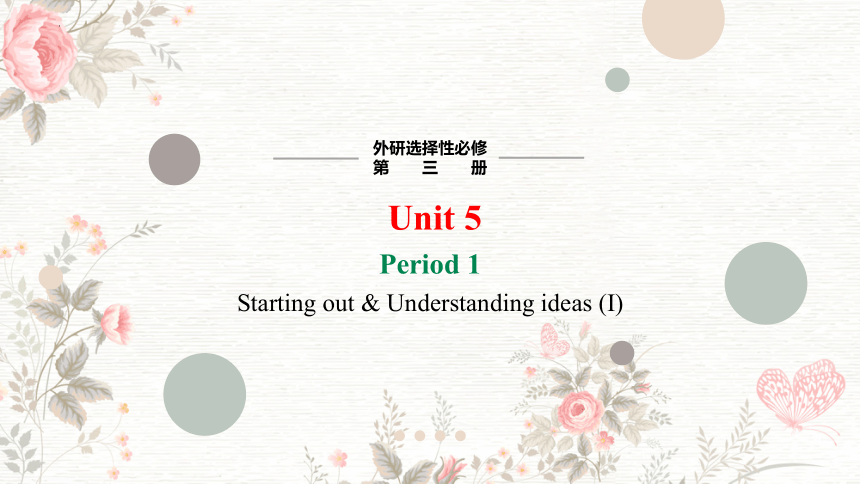 | |
| 格式 | pptx | ||
| 文件大小 | 19.0MB | ||
| 资源类型 | 教案 | ||
| 版本资源 | 外研版(2019) | ||
| 科目 | 英语 | ||
| 更新时间 | 2024-03-21 11:31:45 | ||
图片预览

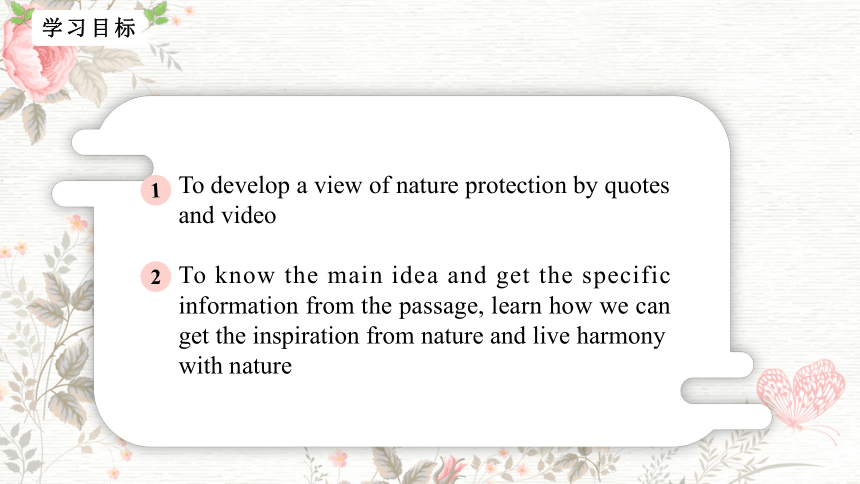
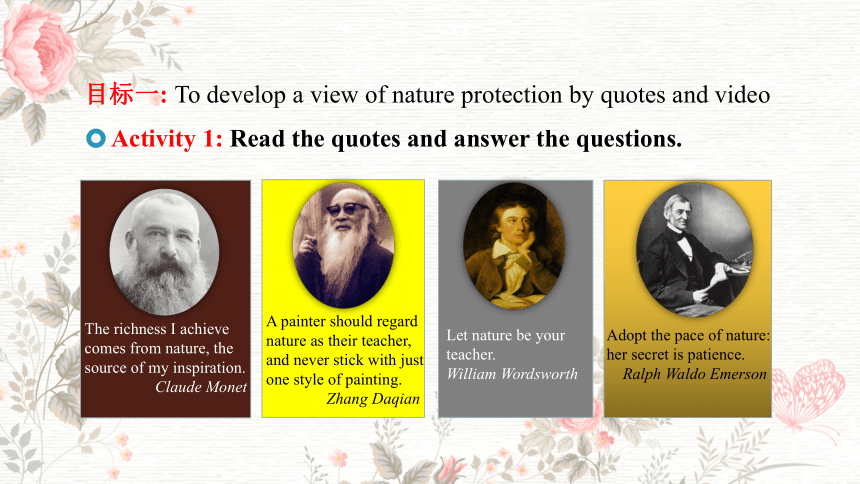
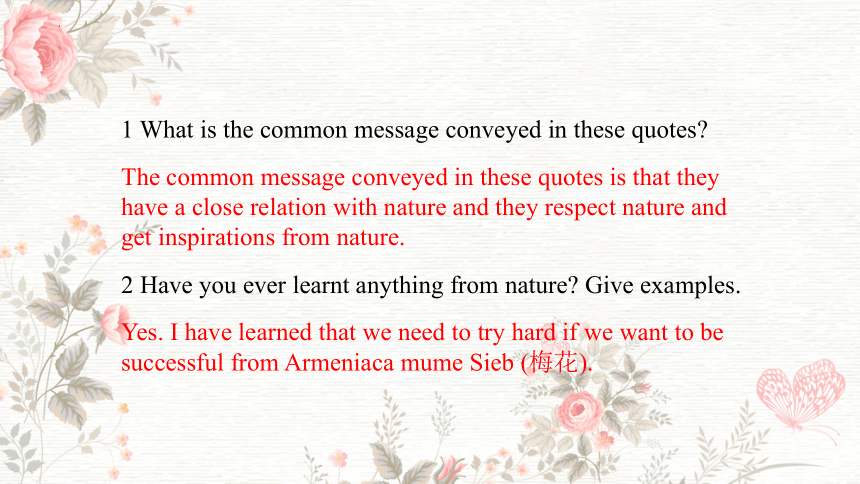
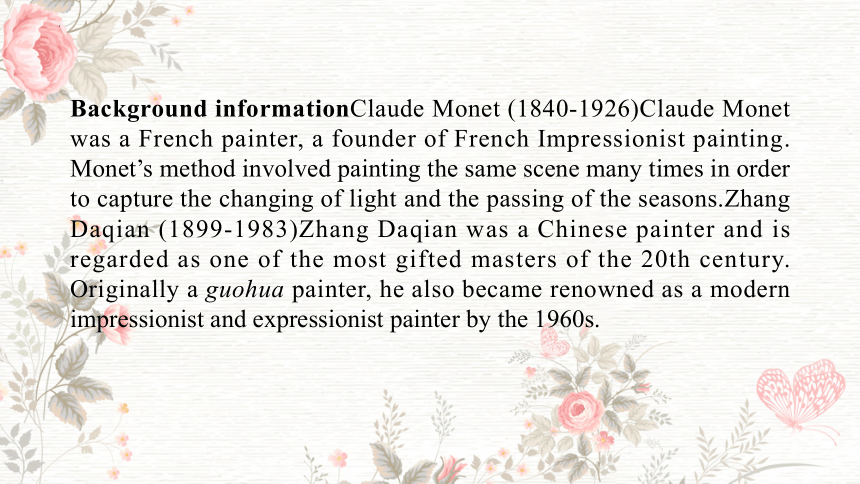
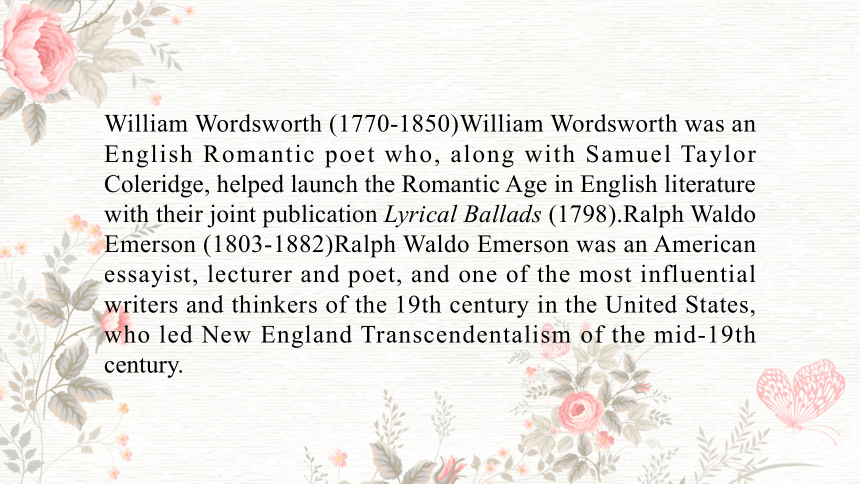
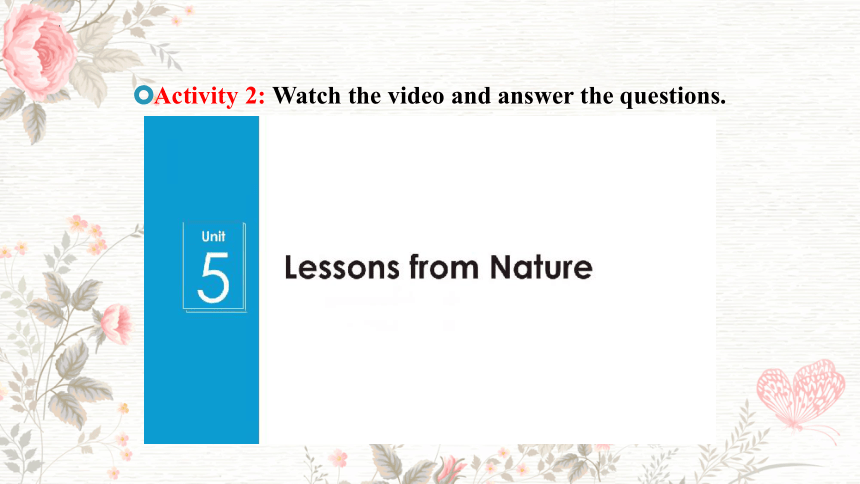
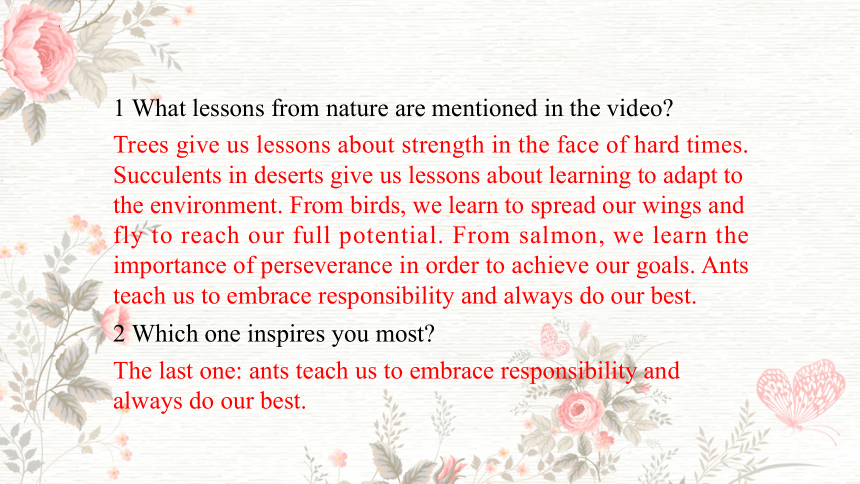
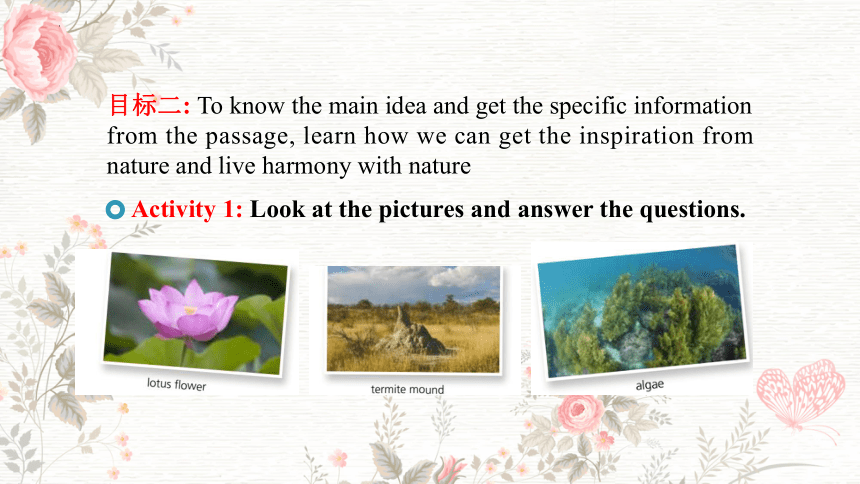
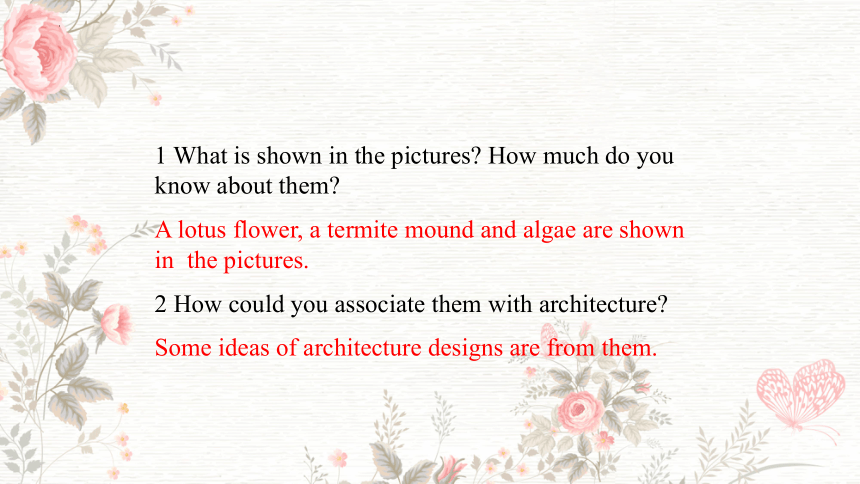
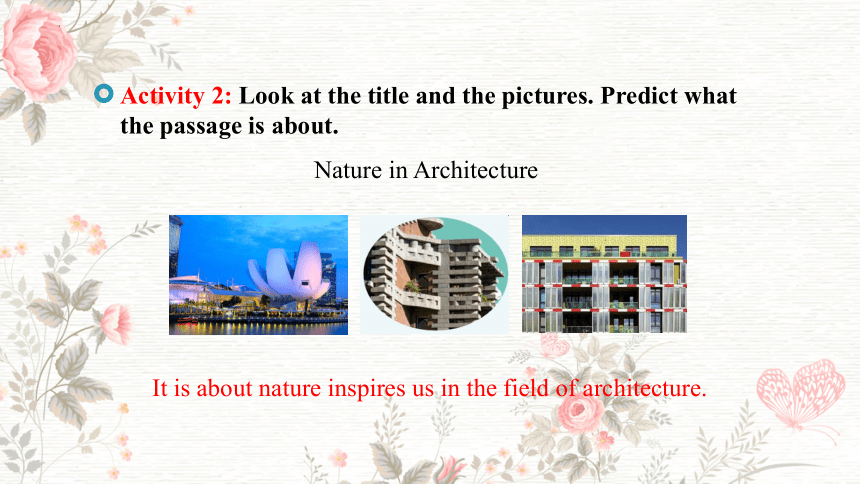
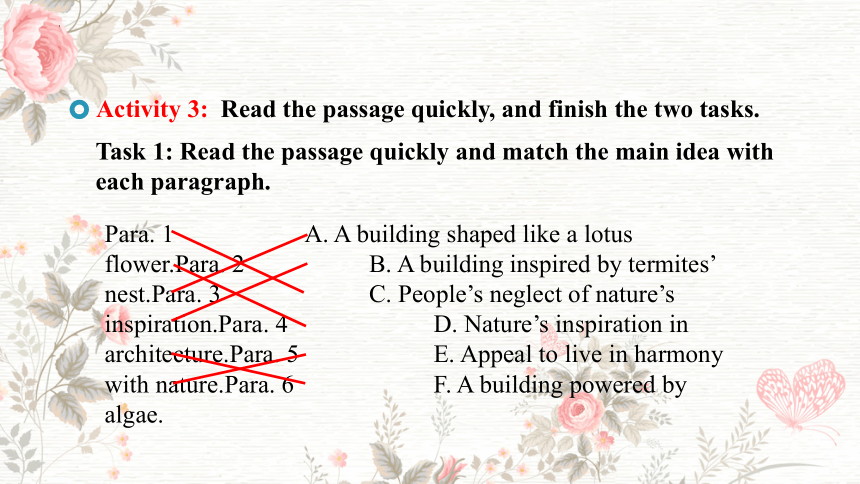
文档简介
(共31张PPT)
外研选择性必修
第三册
Unit 5
Period 1
Starting out & Understanding ideas (I)
1
2
To develop a view of nature protection by quotes and video
To know the main idea and get the specific information from the passage, learn how we can get the inspiration from nature and live harmony with nature
目标一: To develop a view of nature protection by quotes and video
Activity 1: Read the quotes and answer the questions.
The richness I achieve comes from nature, the source of my inspiration.
Claude Monet
A painter should regard nature as their teacher, and never stick with just one style of painting.
Zhang Daqian
Let nature be your teacher.
William Wordsworth
Adopt the pace of nature: her secret is patience.
Ralph Waldo Emerson
1 What is the common message conveyed in these quotes
The common message conveyed in these quotes is that they have a close relation with nature and they respect nature and get inspirations from nature.
2 Have you ever learnt anything from nature Give examples.
Yes. I have learned that we need to try hard if we want to be successful from Armeniaca mume Sieb (梅花).
Background informationClaude Monet (1840-1926)Claude Monet was a French painter, a founder of French Impressionist painting. Monet’s method involved painting the same scene many times in order to capture the changing of light and the passing of the seasons.Zhang Daqian (1899-1983)Zhang Daqian was a Chinese painter and is regarded as one of the most gifted masters of the 20th century. Originally a guohua painter, he also became renowned as a modern impressionist and expressionist painter by the 1960s.
William Wordsworth (1770-1850)William Wordsworth was an English Romantic poet who, along with Samuel Taylor Coleridge, helped launch the Romantic Age in English literature with their joint publication Lyrical Ballads (1798).Ralph Waldo Emerson (1803-1882)Ralph Waldo Emerson was an American essayist, lecturer and poet, and one of the most influential writers and thinkers of the 19th century in the United States, who led New England Transcendentalism of the mid-19th century.
Activity 2: Watch the video and answer the questions.
1 What lessons from nature are mentioned in the video
Trees give us lessons about strength in the face of hard times. Succulents in deserts give us lessons about learning to adapt to the environment. From birds, we learn to spread our wings and fly to reach our full potential. From salmon, we learn the importance of perseverance in order to achieve our goals. Ants teach us to embrace responsibility and always do our best.
2 Which one inspires you most
The last one: ants teach us to embrace responsibility and always do our best.
目标二: To know the main idea and get the specific information from the passage, learn how we can get the inspiration from nature and live harmony with nature
Activity 1: Look at the pictures and answer the questions.
1 What is shown in the pictures How much do you know about them
A lotus flower, a termite mound and algae are shown in the pictures.
2 How could you associate them with architecture
Some ideas of architecture designs are from them.
Activity 2: Look at the title and the pictures. Predict what the passage is about.
Nature in Architecture
It is about nature inspires us in the field of architecture.
Activity 3: Read the passage quickly, and finish the two tasks.
Task 1: Read the passage quickly and match the main idea with each paragraph.
Para. 1 A. A building shaped like a lotus flower.Para. 2 B. A building inspired by termites’ nest.Para. 3 C. People’s neglect of nature’s inspiration.Para. 4 D. Nature’s inspiration in architecture.Para. 5 E. Appeal to live in harmony with nature.Para. 6 F. A building powered by algae.
Task 2: Put the passage into three parts, and summarise the main idea of each part.
Parts Para.s Main ideas
Part 1
Part 2
Part 3
Para.s 1~2
Para.s 3~5
Para. 6
Nature gives us much inspiration.
Some examples for the topic.
Live in harmony with nature.
Activity 4: Choose the magazine in which you would most likely find the passage. Give your reasons.
1 Extraordinary Architects
2 Lying on Earth
3 Architecture Frontier
4 Natural World
(1) From the title and pictures, you can tell that architecture is mentioned in the passage.(2) In the passage, three buildings are listed to illustrate the topic.
Activity 5: Organise information from the passage and complete the diagram.
Introduction There is much inspiration from nature in our daily lives, and nature has also inspired 1___________________________________ around us.
many of the most fascinating designs
Main body
To capture the beauty of natural forms Shaped to resemble a 2____________________ the ArtScience Museum seems to float above the waterfront promenade and 3_____________________. It collects rainwater through the roof and 4____________________ through its own plumbing system. To 5____________________ Based on the form and process of termite mounds, Harare’s Eastgate Centre also has little holes in the walls allowing air to 6___________________________________________ thus reducing the need for 7___________________________________________. In this way, it uses less energy and costs less to run. To 8___________________
______________________
The Algae House is covered in panels containing algae. While the panels provide shade, 9________________ _________ and convert it into energy, the algae can also be used to 10________
___________. The building reduces damage to the environment by 11_______
______________________
______________________.
lotus flower
the water that surrounds it
the water is then recycled
mimic the way nature works
move freely in and out of the building
traditional air conditioning and heating systems
make natural organisms part of a building
capture heat from the sun
produce fuel
generating its own renewable energy
ConclusionNature-inspired buildings enable us to 12___________________________________________.
live in closer harmony with our environment
Now work in pairs and talk about other examples of architecture inspired by nature.
Activity 6: Think & Share
1 Which of the three buildings are you most impressed by Why 2 If you were given a chance to design a building, what inspiration would you take from nature 3 How did the pictures help your understanding of the passage Share your ideas with the class.
外研选择性必修
第三册
Unit 5
Period 1
Starting out & Understanding ideas (II)
Activity 7: Find the important words, phrases, and language points you want to share with your partner. Then discuss in groups and share their usage with the class.
1 take sth. for granted 认为……是理所当然的【教材原文】In fact, we are so used to them that we may even take them for granted without realising how much inspiration they have given us.事实上,我们已经习惯了它们,甚至可能认为它们是理所当然的,没有意识到它们给了我们多少灵感。【句型分析】句中so...that...意为“如此……以至于……”,引导结果状语从句。
2 make sb. do sth. 使某人做某事【教材原文】An open flower might make us think how closely it resembles an umbrella. 一朵开放的花可能会让我们觉得它有多像一把伞。3 It is+adj. (for sb.) to do sth. (对某人来说)做某事怎么样【教材原文】It is natural to think in this way, but of course it wasn’t the umbrella that inspired the flower or the roof that inspired the pine cone.
以这种方式思考是很自然的,但当然不是雨伞给了花朵灵感,也不是屋顶给了松果灵感。【句型分析】本句为并列复合句,表转折关系。句中it wasn’t...that...为强调句型。
4 “make+宾语+宾补”结构【教材原文】Today, architects continue to explore ways to capture the beauty of natural forms, to mimic the way nature works or even to make natural organisms part of a building.今天,建筑师继续探索捕捉自然形态之美,模仿自然的运行方式,甚至使天然有机物成为建筑的一部分。【句型分析】句中make natural organisms part of a building为“make+宾语+宾补”结构,宾补为part of a building。
5 explore the relationship between art and science 探索艺术与科学的关系【教材原文】People whose interest is exploring the relationship between art and science will enjoy Singapore’s ArtScience Museum.
对探索艺术与科学的关系感兴趣的人会喜欢新加坡的艺术科学博物馆。【句型分析】本句由whose引导定语从句修饰people。
6 be designed to 被设计来……
【教材原文】The building was designed to show the connection between nature and the modern city environment in which it sits.
这座建筑的设计是为了展示自然和它所处的现代城市环境之间的联系。
【句型分析】in which it sits为定语从句修饰city environment。
7 shape v. 塑造,使成形【教材原文】Shaped to resemble a lotus flower, it appears to float above the waterfront promenade and the water that surrounds it. 外形酷似一朵莲花,它好像漂浮在海滨长廊和周围的水面上。【句型分析】Shaped to resemble a lotus flower为过去分词短语作原因状语。that surrounds it为定语从句修饰the water。8 capture the beauty of natural forms 捕捉自然形态之美【教材原文】Visitors are often amazed to find themselves in an urban building that so truly captures the beauty of natural forms. 游客们常常惊奇地发现自己置身于一座如此真实地捕捉到自然形态之美的城市建筑中。【句型分析】that so truly captures the beauty of natural forms为定语从句修饰building。
9 base on 基于【教材原文】To use biomimicry is to create structures based on natural forms and processes. 利用仿生技术,在自然形态和过程的基础上创造建筑结构。【句型分析】To use biomimicry为不定式作主语,to create structures为不定式作 表语,based on natural forms and processes为过去分词短语作后置定语。10 nature documentary 自然纪录片【教材原文】Zimbabwean architect Mick Pearce was inspired to create the Centre while watching a nature documentary in which termites were constructing their nests.
津巴布韦建筑师米克·皮尔斯在一部大自然纪录片中看到白蚁筑造蚁穴,从中得到启发,从而设计了东门大厦。【句型分析】in which termites were constructing their nests为定语从句修饰nature documentary。
11 move freely in and out of... 自由进出……【教材原文】The insects built mounds covered in little holes designed to allow air to move freely in and out of the mounds.这种昆虫建造的土堆上布满了小孔,使空气可以自由进出土堆。【句型分析】covered in little holes为过去分词短语作后置定语修饰mounds,designed to allow air to move freely in and out of the mounds过去分词短语作后置定语修饰holes。
12 be drawn into... 被吸收进……【教材原文】During the day, warm air is drawn into the building through the holes, cooling as it reaches the middle of the building. 白天,热空气通过这些孔进入建筑物,当它到达建筑物中部时就会冷却。【句型分析】cooling为现在分词作伴随状语,as引导时间状语从句。13 At night, the heat absorbed by the wall during the day warms the cool air, creating a comfortable temperature inside. 在晚上,墙壁在白天吸收的热量加热了冷空气,在里面创造了一个舒适的温度。【句型分析】absorbed by the wall during the day为过去分词短语作后置定语;creating a comfortable temperature inside为现在分词短语作状语。
14 be fed with... 被用……喂养【教材原文】The algae are fed with liquid nutrients and carbon dioxide to encourage them to grow. 藻类被喂以液体营养物质和二氧化碳来促进它们的生长。【句型分析】to encourage them to grow为不定式作目的状语。15 convert...into... 把……转换成……【教材原文】The panels also capture heat from the sun and convert it into energy that powers the building. 这些面板还可以吸收太阳的热量,并转化为电能,给建筑物供电。【句型分析】from the sun为介词短语作后置定语;that powers the building为定语从句。
16 The building therefore not only responds to its environment and uses less energy, but also reduces damage to the environment by generating its own renewable energy.Paraphrase: Therefore, the building uses less energy, as well as responds to the environment. In addition, it can generate renewable energy, which is less damaging to the environment.本句中含有并列连词not only...but also.,表示并列或递进关系,意为“不但……而且……”。注意not only...but also...与as well as所连接的并列成分各有侧重,not only....but also...是把重点放在后者,as well as是把重点放在前者,因此在转换时一定要调整顺序。例如:Not only the teacher but also the students wish for a holiday.= The students as well as the teacher wish for a holiday.
17 live in harmony with... 与……和谐相处【教材原文】Creating buildings such as these enables us to live in closer harmony with our environment.
创造这样的建筑使我们能够与环境更和谐地相处。
1 Can you share your inspiration from nature 2 Can you list other things inspired by nature
外研选择性必修
第三册
Unit 5
Period 1
Starting out & Understanding ideas (I)
1
2
To develop a view of nature protection by quotes and video
To know the main idea and get the specific information from the passage, learn how we can get the inspiration from nature and live harmony with nature
目标一: To develop a view of nature protection by quotes and video
Activity 1: Read the quotes and answer the questions.
The richness I achieve comes from nature, the source of my inspiration.
Claude Monet
A painter should regard nature as their teacher, and never stick with just one style of painting.
Zhang Daqian
Let nature be your teacher.
William Wordsworth
Adopt the pace of nature: her secret is patience.
Ralph Waldo Emerson
1 What is the common message conveyed in these quotes
The common message conveyed in these quotes is that they have a close relation with nature and they respect nature and get inspirations from nature.
2 Have you ever learnt anything from nature Give examples.
Yes. I have learned that we need to try hard if we want to be successful from Armeniaca mume Sieb (梅花).
Background informationClaude Monet (1840-1926)Claude Monet was a French painter, a founder of French Impressionist painting. Monet’s method involved painting the same scene many times in order to capture the changing of light and the passing of the seasons.Zhang Daqian (1899-1983)Zhang Daqian was a Chinese painter and is regarded as one of the most gifted masters of the 20th century. Originally a guohua painter, he also became renowned as a modern impressionist and expressionist painter by the 1960s.
William Wordsworth (1770-1850)William Wordsworth was an English Romantic poet who, along with Samuel Taylor Coleridge, helped launch the Romantic Age in English literature with their joint publication Lyrical Ballads (1798).Ralph Waldo Emerson (1803-1882)Ralph Waldo Emerson was an American essayist, lecturer and poet, and one of the most influential writers and thinkers of the 19th century in the United States, who led New England Transcendentalism of the mid-19th century.
Activity 2: Watch the video and answer the questions.
1 What lessons from nature are mentioned in the video
Trees give us lessons about strength in the face of hard times. Succulents in deserts give us lessons about learning to adapt to the environment. From birds, we learn to spread our wings and fly to reach our full potential. From salmon, we learn the importance of perseverance in order to achieve our goals. Ants teach us to embrace responsibility and always do our best.
2 Which one inspires you most
The last one: ants teach us to embrace responsibility and always do our best.
目标二: To know the main idea and get the specific information from the passage, learn how we can get the inspiration from nature and live harmony with nature
Activity 1: Look at the pictures and answer the questions.
1 What is shown in the pictures How much do you know about them
A lotus flower, a termite mound and algae are shown in the pictures.
2 How could you associate them with architecture
Some ideas of architecture designs are from them.
Activity 2: Look at the title and the pictures. Predict what the passage is about.
Nature in Architecture
It is about nature inspires us in the field of architecture.
Activity 3: Read the passage quickly, and finish the two tasks.
Task 1: Read the passage quickly and match the main idea with each paragraph.
Para. 1 A. A building shaped like a lotus flower.Para. 2 B. A building inspired by termites’ nest.Para. 3 C. People’s neglect of nature’s inspiration.Para. 4 D. Nature’s inspiration in architecture.Para. 5 E. Appeal to live in harmony with nature.Para. 6 F. A building powered by algae.
Task 2: Put the passage into three parts, and summarise the main idea of each part.
Parts Para.s Main ideas
Part 1
Part 2
Part 3
Para.s 1~2
Para.s 3~5
Para. 6
Nature gives us much inspiration.
Some examples for the topic.
Live in harmony with nature.
Activity 4: Choose the magazine in which you would most likely find the passage. Give your reasons.
1 Extraordinary Architects
2 Lying on Earth
3 Architecture Frontier
4 Natural World
(1) From the title and pictures, you can tell that architecture is mentioned in the passage.(2) In the passage, three buildings are listed to illustrate the topic.
Activity 5: Organise information from the passage and complete the diagram.
Introduction There is much inspiration from nature in our daily lives, and nature has also inspired 1___________________________________ around us.
many of the most fascinating designs
Main body
To capture the beauty of natural forms Shaped to resemble a 2____________________ the ArtScience Museum seems to float above the waterfront promenade and 3_____________________. It collects rainwater through the roof and 4____________________ through its own plumbing system. To 5____________________ Based on the form and process of termite mounds, Harare’s Eastgate Centre also has little holes in the walls allowing air to 6___________________________________________ thus reducing the need for 7___________________________________________. In this way, it uses less energy and costs less to run. To 8___________________
______________________
The Algae House is covered in panels containing algae. While the panels provide shade, 9________________ _________ and convert it into energy, the algae can also be used to 10________
___________. The building reduces damage to the environment by 11_______
______________________
______________________.
lotus flower
the water that surrounds it
the water is then recycled
mimic the way nature works
move freely in and out of the building
traditional air conditioning and heating systems
make natural organisms part of a building
capture heat from the sun
produce fuel
generating its own renewable energy
ConclusionNature-inspired buildings enable us to 12___________________________________________.
live in closer harmony with our environment
Now work in pairs and talk about other examples of architecture inspired by nature.
Activity 6: Think & Share
1 Which of the three buildings are you most impressed by Why 2 If you were given a chance to design a building, what inspiration would you take from nature 3 How did the pictures help your understanding of the passage Share your ideas with the class.
外研选择性必修
第三册
Unit 5
Period 1
Starting out & Understanding ideas (II)
Activity 7: Find the important words, phrases, and language points you want to share with your partner. Then discuss in groups and share their usage with the class.
1 take sth. for granted 认为……是理所当然的【教材原文】In fact, we are so used to them that we may even take them for granted without realising how much inspiration they have given us.事实上,我们已经习惯了它们,甚至可能认为它们是理所当然的,没有意识到它们给了我们多少灵感。【句型分析】句中so...that...意为“如此……以至于……”,引导结果状语从句。
2 make sb. do sth. 使某人做某事【教材原文】An open flower might make us think how closely it resembles an umbrella. 一朵开放的花可能会让我们觉得它有多像一把伞。3 It is+adj. (for sb.) to do sth. (对某人来说)做某事怎么样【教材原文】It is natural to think in this way, but of course it wasn’t the umbrella that inspired the flower or the roof that inspired the pine cone.
以这种方式思考是很自然的,但当然不是雨伞给了花朵灵感,也不是屋顶给了松果灵感。【句型分析】本句为并列复合句,表转折关系。句中it wasn’t...that...为强调句型。
4 “make+宾语+宾补”结构【教材原文】Today, architects continue to explore ways to capture the beauty of natural forms, to mimic the way nature works or even to make natural organisms part of a building.今天,建筑师继续探索捕捉自然形态之美,模仿自然的运行方式,甚至使天然有机物成为建筑的一部分。【句型分析】句中make natural organisms part of a building为“make+宾语+宾补”结构,宾补为part of a building。
5 explore the relationship between art and science 探索艺术与科学的关系【教材原文】People whose interest is exploring the relationship between art and science will enjoy Singapore’s ArtScience Museum.
对探索艺术与科学的关系感兴趣的人会喜欢新加坡的艺术科学博物馆。【句型分析】本句由whose引导定语从句修饰people。
6 be designed to 被设计来……
【教材原文】The building was designed to show the connection between nature and the modern city environment in which it sits.
这座建筑的设计是为了展示自然和它所处的现代城市环境之间的联系。
【句型分析】in which it sits为定语从句修饰city environment。
7 shape v. 塑造,使成形【教材原文】Shaped to resemble a lotus flower, it appears to float above the waterfront promenade and the water that surrounds it. 外形酷似一朵莲花,它好像漂浮在海滨长廊和周围的水面上。【句型分析】Shaped to resemble a lotus flower为过去分词短语作原因状语。that surrounds it为定语从句修饰the water。8 capture the beauty of natural forms 捕捉自然形态之美【教材原文】Visitors are often amazed to find themselves in an urban building that so truly captures the beauty of natural forms. 游客们常常惊奇地发现自己置身于一座如此真实地捕捉到自然形态之美的城市建筑中。【句型分析】that so truly captures the beauty of natural forms为定语从句修饰building。
9 base on 基于【教材原文】To use biomimicry is to create structures based on natural forms and processes. 利用仿生技术,在自然形态和过程的基础上创造建筑结构。【句型分析】To use biomimicry为不定式作主语,to create structures为不定式作 表语,based on natural forms and processes为过去分词短语作后置定语。10 nature documentary 自然纪录片【教材原文】Zimbabwean architect Mick Pearce was inspired to create the Centre while watching a nature documentary in which termites were constructing their nests.
津巴布韦建筑师米克·皮尔斯在一部大自然纪录片中看到白蚁筑造蚁穴,从中得到启发,从而设计了东门大厦。【句型分析】in which termites were constructing their nests为定语从句修饰nature documentary。
11 move freely in and out of... 自由进出……【教材原文】The insects built mounds covered in little holes designed to allow air to move freely in and out of the mounds.这种昆虫建造的土堆上布满了小孔,使空气可以自由进出土堆。【句型分析】covered in little holes为过去分词短语作后置定语修饰mounds,designed to allow air to move freely in and out of the mounds过去分词短语作后置定语修饰holes。
12 be drawn into... 被吸收进……【教材原文】During the day, warm air is drawn into the building through the holes, cooling as it reaches the middle of the building. 白天,热空气通过这些孔进入建筑物,当它到达建筑物中部时就会冷却。【句型分析】cooling为现在分词作伴随状语,as引导时间状语从句。13 At night, the heat absorbed by the wall during the day warms the cool air, creating a comfortable temperature inside. 在晚上,墙壁在白天吸收的热量加热了冷空气,在里面创造了一个舒适的温度。【句型分析】absorbed by the wall during the day为过去分词短语作后置定语;creating a comfortable temperature inside为现在分词短语作状语。
14 be fed with... 被用……喂养【教材原文】The algae are fed with liquid nutrients and carbon dioxide to encourage them to grow. 藻类被喂以液体营养物质和二氧化碳来促进它们的生长。【句型分析】to encourage them to grow为不定式作目的状语。15 convert...into... 把……转换成……【教材原文】The panels also capture heat from the sun and convert it into energy that powers the building. 这些面板还可以吸收太阳的热量,并转化为电能,给建筑物供电。【句型分析】from the sun为介词短语作后置定语;that powers the building为定语从句。
16 The building therefore not only responds to its environment and uses less energy, but also reduces damage to the environment by generating its own renewable energy.Paraphrase: Therefore, the building uses less energy, as well as responds to the environment. In addition, it can generate renewable energy, which is less damaging to the environment.本句中含有并列连词not only...but also.,表示并列或递进关系,意为“不但……而且……”。注意not only...but also...与as well as所连接的并列成分各有侧重,not only....but also...是把重点放在后者,as well as是把重点放在前者,因此在转换时一定要调整顺序。例如:Not only the teacher but also the students wish for a holiday.= The students as well as the teacher wish for a holiday.
17 live in harmony with... 与……和谐相处【教材原文】Creating buildings such as these enables us to live in closer harmony with our environment.
创造这样的建筑使我们能够与环境更和谐地相处。
1 Can you share your inspiration from nature 2 Can you list other things inspired by nature
